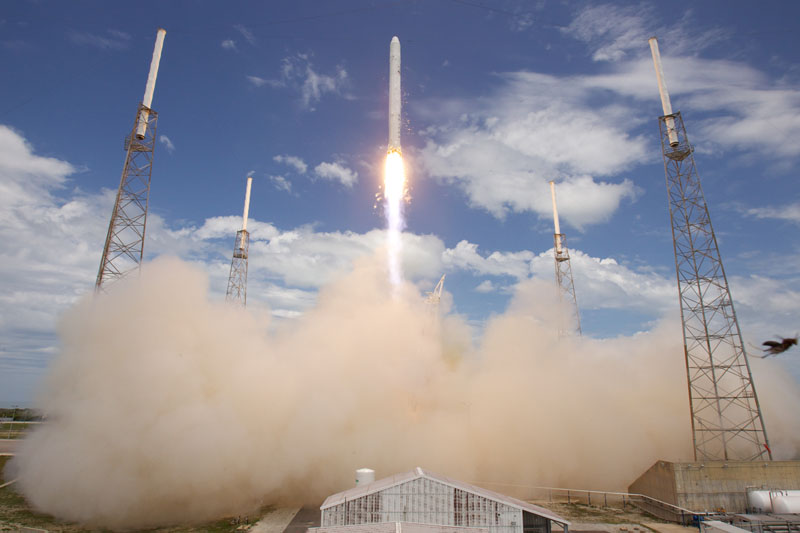
With the recent successful launch of a new private rocket, called Falcon 9, and a space capsule mock-up from Florida's Cape Canaveral Air Station, some skywatchers might be wondering if it will be consistently visible from the ground like many other bright artificial satellites. The answer, apparently, is no.
That determination comes from some of the die-hard satellite observers, who just last month were able to locate and then track the U.S. Air Force's secret X-37B space plane.
Observers from around the world have since been able to get views of the X-37B as it moved across the twilight sky with the brightness of a moderately bright star. That vehicle is orbiting approximately 250 statute miles (402 km) above Earth, inclined 40 degrees to the Earth's equator.
But catching a glimpse of the Falcon 9 rocket, which launched Friday from Florida, is more difficult, in part due to a much lower orbital altitude of 155 statute miles (250 km), as well as a lower orbital inclination of 34.5 degrees. These two factors restrict visibility to a much smaller area. [Spotting spaceships from Earth.]
However, the Falcon 9 rocket built by the California-based company Space Exploration Technologies (SpaceX) may have had one last hurrah following its successful maiden launch last week. Before fading into the background of space, the rocket likely was responsible for a short-lived — but dazzling — spiral of light seen over parts of Australia that spawned a flurry of UFO reports, according to Australian news reports.
"I heard people in Australia thought UFOs were visiting :)," SpaceX's millionaire founder Elon Musk told SPACE.com in an e-mail. "The venting of propellants, which is done to ensure that an overpressure event doesn't produce orbital debris, created a temporary halo caught the sun at just the right angle for a great view from Australia. I thought the pictures looked really cool."
Viewing Circumstances Poor
The less-than-optimistic assessment comes from members of SeeSat-L, around the world.
Get the Space.com Newsletter
Breaking space news, the latest updates on rocket launches, skywatching events and more!
Kevin Fetter, a SeeSat-L member from Brockville, Ontario notes that, "As for seeing it, the conditions are bad. It was placed into a orbit, with a low orbital height. The orbital inclination is only 34 degrees, so a lot of people are out of luck."
Ted Molczan, the SeeSat-L Moderator concurs with Fetter, adding that even limited visibility of Falcon 9 is now compromised by the fact that for the next couple of weeks Falcon 9 will be making passes during the daytime and hence will be unobservable.
"A quick check of current visibility north of the equator, reveals the tail end of evening visibility at latitudes south of about 30 N; no visibility further north," noted Molczan. "Morning window opens in a couple of weeks. South of the equator, around 35 S, has tail end (several days) of morning visibility."
Was likely Australian UFO
But as obscure as Falcon 9 has been for even experienced satellite watchers to see, it likely was responsible for a rash of UFO reports on Saturday morning over New South Wales, Queensland and the Australian Capital Territory of Canberra.
A strange spiral cloud with a yellowish-green tint suddenly appeared in the predawn sky. Some described it as a "lollipop-type swirl," according to the Australian Broadcasting Corp. Others say it hovered for a while before gradually moving in an eastern direction until it was out of sight.
One eyewitness described it having a "distinct bright centre, much like a bright star, indicating an object shedding light trails, spiraling and fattening out from it." Many commented that the effect lasted only two or three minutes before it descended quickly out of view.
But Molczan believes that what the Australians saw was in reality, Falcon 9.
"The Falcon 9 test payload ('Dragon'), which is attached to the rocket's 2nd stage), appears to account for the phenomenon. (The UFO sightings) occurred about 65 min. after launch, so perhaps the 2nd stage was dumping excess propellant. Similar actions by Centaur stages have always resulted in spectacular cloud-like formations," Molczan wrote.
A similar sight was widely visible from parts of North America back in 2004, as well as over Norway and Russia in December 2009. A Russian Bulava missile caused that December event.
Joe Rao serves as an instructor and guest lecturer at New York's Hayden Planetarium. He writes about astronomy for The New York Times and other publications, and he is also an on-camera meteorologist for News 12 Westchester, New York. SPACE.com Managing Editor Tariq Malik contributed to this report.
Join our Space Forums to keep talking space on the latest missions, night sky and more! And if you have a news tip, correction or comment, let us know at: community@space.com.

Joe Rao is Space.com's skywatching columnist, as well as a veteran meteorologist and eclipse chaser who also serves as an instructor and guest lecturer at New York's Hayden Planetarium. He writes about astronomy for Natural History magazine, Sky & Telescope and other publications. Joe is an 8-time Emmy-nominated meteorologist who served the Putnam Valley region of New York for over 21 years. You can find him on Twitter and YouTube tracking lunar and solar eclipses, meteor showers and more. To find out Joe's latest project, visit him on Twitter.











